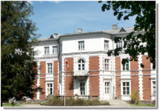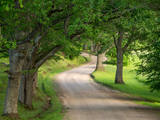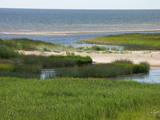| Nr | Nosaukums | Apraksts |
|---|---|---|
|
Kafejnīca "Rositten" atrodas blakus Rēzeknes pilskalnam – Austrumlatvijas radošo pakalpojumu centram „Zeimuļs” (uzbūvēts 01.09.2012.). Skaists interjers un skats uz Rēzeknes kultūrvēsturiskajiem objektiem. Nosaukta cietokšņa (Rositten) vārdā, ko 13. gs. šeit uzcēla Livonoijas ordeņa mestrs. Piedāvā maltītes visām ēdienreizēm, kulinārijas un konditorejas izstrādājumus. |
||
|
Vilsandi bāka sāka darboties 1809. g. Ja uzmanīgi palūkojas uz torņa, labi redzams, ka tas ir vairākas reizes paaugstināts. Tagadējās bākas augstums ir 37 m, bet gaismas elements atrodas 40 metrus virs jūras līmeņa. Bāka ar apkārtējām ēkām ir apskatāma tikai no ārpuses. Ja pa Vilsandi arhipelāgu ceļo ar jūras laivu vai citu peldlīdzekli, tad bāka kalpo kā ļoti labs orientieris daudzo salu, līču un pussalu labirintā. No bākas redzama jūras krastā uzceltā glābšanas stacija. Pateicoties tai, Vilsandi ūdeņos izglābti 29 cilvēki, 2 suņi un 1 kaķis. Tā stāsta vietējie. |
||
|
Iekārtots bijušā Džūkstes – Lancenieku skolā, kur ikviens var iepazīt mūsu „Pasaku tēva” – Anša Lerha-Puškaita devumu folkloras mantojuma vākšanā.
|
||
|
Pilsētā nebija lielu rūpniecības uzņēmumu, un tās iedzīvotāji
nodarbojās galvenokārt ar amatniecību, tirdzniecību un lauksaimniecību.
Ilūkste tika pilnībā nopostīta 1. pasaules kara laikā un smagi cieta arī
2. pasaules kara laikā. Šodien Ilūkste ir klusa pierobežas mazpilsēta, ko
ieskauj gleznains dabas apvidus. Apskates objekti: bijušā jezuītu klostera ēka
un Ilūkstes katoļu baznīca.
|
||
|
No Kokneses muižas ēkām līdz mūsdienām ir saglabājusies pārvaldnieka ēka, kurā laikā no 1885. - 1887. g. dzīvojis latviešu rakstnieks Rūdolfs Blaumanis (1863. – 1908., uzstādīta piemiņas plāksne) un mūra stallis, kas celts no laukakmeņiem. Tajā atrodas a/s „Latvijas Valsts meži” Vidusdaugavas mežniecība. Kokneses vidusskolas akmens vārti ir bijušās muižas vārti. Muižas ēkas apskatāmas g.k. no ārpuses. |
||
|
Ūla ir viena no skaistākajām un likumsakarīgi – arī populārākajām Lietuvas ūdenstūristu upēm. Tās galvenā pievilcība ir skaistā ainava ar augstajiem upes krastiem, kuros slejas iespaidīgas smilšu kraujas līdzīgi kā Irbes krastos Latvijā. Laivošanu var sākt no Mančagires (Mančiagirė) vai Zervinos ciemiem un turpināt līdz Ūlas ietekai Merķē un tālāk pa Merķi līdz pat Merķinei un Nemunai. Ūla nav plata, taču posmā no Zervinos ciema tajā nav neviena koku aizgāzuma vai cita šķēršļa, kuram laiva būtu jānes apkārt. Ašā straume, asie līkumi, dzidrais ūdens un tajā redzamā zemūdens pasaule rada patiesi patīkamu sajūtu! Upes krastos atrodas gan publiskas (apsaimnieko Lietuvas valsts meži), gan privātas ūdenstūristu apmetnes un atpūtas vietas. Šī ir vienīgā Baltijas upe, kur ūdenstūristiem ir jāpērk licence. Ūlas krastos atrodas divi interesanti apskates objekti – Ūlas atsegums (Ūlos atodanga) un spēcīgs avots – Ūlas acs (Ūlos akis). Savukārt, Merķe jau ir jau krietni platāka upe, taču ar acīm redzamu straumi un dažviet pat jaukām straujtecēm. Kaut arī Merķes krasti ir mazapdzīvoti, tajos atradīsim piemērotas nakšņošanas vietas. Pa Ūlu un Merķi no Zervinos līdz Merķinei sanāk „mierīgs” pusotras - divas dienas ilgs brauciens. |
||
|
Altjas vēsture iestiepjas 15. gs. vidū. Altja ir sens zvejniekciems, kur jūras krastā ir apskatāmi pirms gandrīz četrdesmit gadiem atjaunotie šķūņi, kur zvejnieki glabāja tīklus un citu inventāru. Mūsdienās šķūņiem ir vairāk ainaviska vērtība, jo tie netiek izmantoti. Turpat meklējama akmeņu kaudze, kur ikviens var atstāt savu akmeni ar iedomātu vēlēšanos. Noteikti ir apmeklējams Altjas krogs (Altja kõrts) – no guļbaļķiem celta ēka ar niedru jumtu, kur var nobaudīt Igaunijas nacionālos ēdienus. Ja iepazīta Altja, var doties pārgājienā pa Oandu taku. Tai ir dažāda garuma posmi – sākot ar dažus kilometrus garo Altjas apkārtnes izziņas taku (3 km) un 0,7 km garo Bebru taku (Koprarada), līdz pat 79 km garajam vairākdienu Kirves (Kõrve) pārgājienu maršrutam. |
||
|
~ 3 – 5 km gara taka, kas ved pa veco ceļu gar Tēramā upes (Tõramaa jõgi) kreiso krastu. Takas malās izvietoti interaktīvi elementi bērniem, kas palīdz labāk uztvert dabā notiekošo. Taku ieskauj mitrie meži un palieņu pļavas, kas palu laikā atrodas zem ūdens. Tēramā (Tõramaa) ciemā apkārtnē atrastas cilvēka darbības pēdas jau no akmens laikmeta. |
||
|
Bebrenes muižas ansamblis (baroka stils)veidojies 19. gs. beigās - 20. gs. sākumā. Tā galvenā dominante ir 1896. g. celtā (arhitekts L. J. L. Markoni) grāfu Plāteru - Zībergu pils, kuras telpās izvietojusies Bebrenes vidusskola. Līdz mūsdienām saglabājušies grezni vārti un neierasta izskata mūra žogs. Muižu ieskauj parks ar regulāra plānojuma parteru un bagātīgu svešzemju kokaugu sugu stādījumiem. |
||
|
Saglabājusies tikai neliela daļa no varenajiem zariem, no kuriem resnākie ir atbalstīti ar stutēm, bet ozola dobo vidu no lietus un sniega ūdeņiem aizsargā jumtiņš. Latvijas un Baltijas resnākais parastais ozols (Quercus robur) un resnākais Baltijas koks. Viens no Ziemeļeiropas resnākajiem ozoliem. Ainavisks. Netālu no ozola atrodas autostāvlaukums, informācijas stends.
|
||
|
Senie tirdzniecības ceļi izplatīja ne tikai preces, bet arī zināšanas un kultūru, visu tobrīd jauno un nezināmo. |
||
|
Dabas piemineklis - aizsargājamie dendroloģiskie stādījumi „Vārkavas parks” atrodas Upmalas pagastā, tā platība ir 2,7 ha, aizsardzībā kopš 2001. gada, teritoriju apsaimnieko Vārkavas novada dome. Parks ierīkots 19. gs. Sākumā, spriežot pēc lielākiem ozoliem ( ap 200 g. veci), pārējie stādījumi ierīkoti 19.gs beigās. Parkā aug vietējās koku un krūmu sugas - kļavas, oši, egles, apses, ozoli, trauslais vītols, liepas, gobas, lazdas, Eiropas segliņi, ievas u.c., kā arī parkā aug vairāk nekā 10 eksotu koku un krūmu sugas, nozīmīgākās no tām – aslapu kļava, cukura kļava, pūkainais filadelfs, smaržīgā apse, sudrabvītols, Ungārijas ceriņš, Krimas liepa, platlapu liepa. |
||
|
Gastrobārs Klaips ir vieta Ādažos, kur ieturēt maltīti gan ikdienā, gan svētkos. Piedāvājumā 9 valstu "street food" ēdieni, kā arī Latvijas modernās virtuves gaļas, zivju un veģetārie ēdieni. Plašs dzērienu piedāvājums. |
||
|
Atrodas t.s. Baznīcu kalnā - A. Pumpura ielā 11 a. Varenais neobaroka stilā celtais dievnamu tapis 1905. g. Pastāv viedoklis, ka par šīs baznīcas prototipu izmantotas Aglonas vai Krāslavas bazilikas, kā arī Rietumeiropas baznīcu paraugi. Tās interjeru rotā divstāvīgs altāris, kurā novietota spāņu gleznotāja B. E. Muriljo pazīstamās gleznas “Svētā Dievmāte” kopija. 1909. g. baznīcā uzstādīja poļu meistara Ādolfa Hofmana būvētās ērģeles.No būvniecības laika saglabājusies arī pārējā baznīcas iekārta. |
||
|
Atrodas Jaunpiebalgas centrā. Tās celtniecības būvdarbus laikā no 1801. - 1804. g. vadīja Cēsu būvmeistars Fridrihs Veits. Dievnama altāra centrā atrodas glezna “Kristus pie krusta” (19. gs. otrā puse). Zvans liets 1895. g., bet ērģeles tapušas 1914. g. Baznīcas ieejas priekšā paceļas 1930. g. atklātais piemineklis 1. pasaules karā un Latvijas Brīvības cīņās kritušajiem (tēlnieks K. Zāle, arhitekts A. Birzenieks). Pavisam nesen ir pabeigti baznīcas fasādes restaurācijas darbi, un šobrīd notiek dievnama interjera restaurācija, tādēļ tas apskatāms tikai no ārpuses. |
||
|
„Ainaži – Salacgrīva” - nozīmīga teritorija rifu aizsardzībai. Teritorija atrodas iepretim Salacgrīvas novadam, tās platība ir 7239 ha.
|
||
|
Sabiles Sidra nams atrodas pašā Sabiles centrā, pie vēsturiskā Sabiles vīna kalna. Tajā tiek piedāvātas sidra un vīna degustācijas. Sidra nams atvērts vasaras sezonā, bet degustācijas ziemas sezonā iespējamas Sabiles Sidra darītavā, Rīgas iela 22. Iespēja iegādāties gan Sabiles sidru, gan dažādu Latvijas vīndaru vīnus. |
||
|
Hiiu Gourmet ir mazs uzņēmums, kura mērķis ir piedāvāt produktus no vietējām izejvielām Hījumā. Izstrādājumi tiek izgatavoti ar rokām mazos daudzumos. Produktu klāstā ir mājās gatavoti sīrupi, piedevas, sinepes utt. No augiem un ogām, kas novāktas Hījumā mežos. Saimniece Heli padāvā Hījumā tradicionālā ēdiena gatavošanas meistarklases. |
||
|
Pašā Lahemā nacionālā parka vidū atrodas savdabīga vieta – Jānioja rokdarbu sēta. Ar akmeņiem apmalotais ceļš aizvedīs līdz dzeltenai saimnieku mājai, kur netālu atrodas telšu laukums un ugunskura vieta, savdabīga lauka virtuve, veca, liela baļķu māja, pirts un smēde.Rokdarbu sētā tiek rīkotas radošās nometnes, rokdarbu kursi, pasaku iestudējumi, gadskārtu ieražu svētki un meistarošana visai ģimenei.Pārdošanā ir tepat darinātās lupatu lelles mirdzošām acīm, mamzeles Janikas lupatu vamži un citi savdabīgi rokdarbi. |
||
|
The farm on the banks of the River Navesti is Estonia's largest company engaged in the cultivation and processing of organic medicinal herbs. The farm has an education and health path of medicinal herbs, open from May to September. Farm has a tea house completed in 2010 which is suitable for holding seminars, relaxing and in the summertime also for having meals. Herb presentations are held there - first on the field and then in the tea house. There is also a 13-metre viewing tower by the river from which you can get a good overview of the lands of the farm. Energy Farm also offers accomodation and Eco-Spa with sauna. |
||























